High Acceptance of COVID-19 Tracing Technologies in Taiwan: A Nationally Representative Survey Analysis
Abstract
:1. Introduction
1.1. Mobile Tracing Technologies
1.2. Technology Acceptance
2. Materials and Methods
2.1. Participants
2.2. Design and Procedure
2.3. Scenario Descriptions
2.4. Data Analysis and Reporting
2.4.1. Likert Comparisons
2.4.2. Predictive Modeling
3. Results
3.1. Tracing Technologies
3.2. Acceptance
3.3. Regression Modeling
4. Discussion
4.1. Principal Results
4.2. Limitations
4.3. Real World Applications
4.4. Comparison with Prior Work
5. Conclusions
Supplementary Materials
Author Contributions
Funding
Institutional Review Board Statement
Informed Consent Statement
Data Availability Statement
Conflicts of Interest
References
- Wu, W.-K.; Liou, J.-M.; Hsu, C.-C.; Lin, Y.-H.; Wu, M.-S. Pandemic preparedness in Taiwan. Nat. Biotechnol. 2020, 38, 932–933. [Google Scholar] [CrossRef] [PubMed]
- Wang, C.J.; Ng, C.; Brook, R.H. Response to COVID-19 in Taiwan: Big data analytics, new technology, and proactive testing. JAMA 2020, 323, 1341–1342. [Google Scholar] [CrossRef] [PubMed]
- Delen, D.; Eryarsoy, E.; Davazdahemami, B. No Place Like Home: Cross-National Data Analysis of the Efficacy of Social Distancing During the COVID-19 Pandemic. JMIR Public Health Surveill. 2020, 6, e19862. [Google Scholar] [CrossRef] [PubMed]
- Roser, M.; Ritchie, H.; Ortiz-Ospina, E.; Hasell, J. Taiwan: Coronavirus Pandemic Country Profile. Our World in Data. Available online: https://ourworldindata.org/coronavirus/country/taiwan (accessed on 2 April 2021).
- Liu, L. Taiwan Launches Social Distancing App. Available online: https://www.taiwannews.com.tw/en/news/4193136 (accessed on 5 April 2021).
- Google. Exposure Notifications: Using Technology to Help Public Health Authorities Fight COVID-19. Available online: https://www.google.com/covid19/exposurenotifications/ (accessed on 4 February 2021).
- Laufer, R.S.; Wolfe, M. Privacy as a Concept and a Social Issue: A Multidimensional Developmental Theory. J. Soc. Issues 1977, 33, 22–42. [Google Scholar] [CrossRef]
- Oliver, N.; Lepri, B.; Sterly, H.; Lambiotte, R.; Deletaille, S.; De Nadai, M.; Letouzé, E.; Salah, A.A.; Benjamins, R.; Cattuto, C.; et al. Mobile phone data for informing public health actions across the COVID-19 pandemic life cycle. Sci. Adv. 2020, 6, eabc0764. [Google Scholar] [CrossRef] [PubMed]
- Lee, Y. Taiwan’s New ‘Electronic Fence’ for Quarantines Leads Wave of Virus Monitoring. Reuters Technology News. Available online: https://www.reuters.com/article/us-health-coronavirus-taiwan-surveillanc-idUSKBN2170SK (accessed on 25 March 2021).
- Trogh, J.; Plets, D.; Surewaard, E.; Spiessens, M.; Versichele, M.; Martens, L.; Joseph, W. Outdoor location tracking of mobile devices in cellular networks. EURASIP J. Wirel. Commun. Netw. 2019, 2019, 115. [Google Scholar] [CrossRef]
- United States Air Force. GPS Accuracy. Available online: https://www.gps.gov/systems/gps/performance/accuracy/\#:~:text= Forexam-ple,GPS-enabledsmartphones,receiversand/oraugmentationsystems (accessed on 4 February 2021).
- Biddle, S. The Inventors of Bluetooth Say There Could Be Problems Using Their Tech for Coronavirus Contact Tracing. The Intercept. Available online: https://theintercept.com/2020/05/05/coronavirus-bluetooth-contact-tracing (accessed on 20 March 2021).
- Samsung. What Is the Maximum Range of a Bluetooth Connection? Available online: https://www.samsung.com/levant/support/mobile-devices/what-is-the-maximum-range-of-a-bluetooth-connection (accessed on 20 March 2021).
- Australian Government Department of Health. Background to COVIDsafe. Available online: https://www.covidsafe.gov.au/background.html (accessed on 19 March 2021).
- German Government Department of Health. Corona-Warn-App Open Source Project. Available online: https://www.coronawarn.app/en/ (accessed on 20 March 2021).
- Ferretti, L.; Wymant, C.; Kendall, M.; Zhao, L.; Nurtay, A.; Abeler-Dörner, L.; Parker, M.; Bonsall, D.G.; Fraser, C. Quantifying SARS-CoV-2 transmission suggests epidemic control with digital contact tracing. Science 2020, 368, eabb6936. [Google Scholar] [CrossRef] [Green Version]
- Georgieva, I.; Beaunoyer, E.; Guitton, M.J. Ensuring social acceptability of technological tracking in the COVID-19 context. Comput. Hum. Behav. 2021, 116, 106639. [Google Scholar] [CrossRef]
- Abraham, S.; Sheeran, P. The health belief model. In Cambridge Handbook of Psychology, Health and Medicine, 2nd ed.; Cambridge University Press: Cambridge, UK, 2014; pp. 97–102. [Google Scholar]
- Fox, G.; Clohessy, T.; van der Werff, L.; Rosati, P.; Lynn, T. Exploring the competing influences of privacy concerns and positive beliefs on citizen acceptance of contact tracing mobile applications. Comput. Hum. Behav. 2021, 121, 106806. [Google Scholar] [CrossRef]
- The Academy of the Social Sciences in Australia. Changes in Public Sentiment in Relation to Data Privacy during COVID-19. Australian Academy of Science 2020. Available online: https://socialsciences.org.au/publications/changes-in-public-sentiment-in-relation-to-data-privacy-during-covid-19/ (accessed on 7 February 2021).
- Chan, E.Y.; Saqib, N.U. Privacy concerns can explain unwillingness to download and use contact tracing apps when COVID-19 concerns are high. Comput. Hum. Behav. 2021, 119, 106718. [Google Scholar] [CrossRef]
- Dienlin, T.; Metzger, M. An Extended Privacy Calculus Model for SNSs: Analyzing Self-Disclosure and Self-Withdrawal in a Representative U.S. Sample. J. Comput. Mediat. Commun. 2016, 21, 368–383. [Google Scholar] [CrossRef] [Green Version]
- Garrett, P.M.; White, J.P.; Lewandowsky, S.; Kashima, Y.; Perfors, A.; Little, D.R.; Geard, N.; Mitchell, L.; Tomko, M.; Dennis, S. The acceptability and uptake of smartphone tracking for COVID-19 in Australia. PLoS ONE 2021, 16, e0244827. [Google Scholar] [CrossRef] [PubMed]
- Barzilay, R.; Moore, T.M.; Greenberg, D.M.; DiDomenico, G.E.; Brown, L.A.; White, L.K.; Gur, R.C.; Gur, R.E. Resilience, COVID-19-related stress, anxiety and depression during the pandemic in a large population enriched for healthcare providers. Transl. Psychiatry 2020, 10, 291. [Google Scholar] [CrossRef] [PubMed]
- Lewandowsky, S.; Dennis, S.; Perfors, A.; Kashima, Y.; White, J.P.; Garrett, P.; Little, D.; Yesilada, M. Public acceptance of privacy-encroaching policies to address the COVID-19 pandemic in the United Kingdom. PLoS ONE 2021, 16, e0245740. [Google Scholar] [CrossRef] [PubMed]
- Garrett, P.M.; Dennis, S.J. Australia Has All but Abandoned the COVIDsafe App in Favour of QR Codes (so Make Sure You Check in). The Conversation 2021. Available online: https://theconversation.com/australia-has-all-but-abandoned-the-covidsafe-app-in-favour-of-qr-codes-so-make-sure-you-check-in-161880?utm_medium=Social&utm_source=Twitter#Echobox=1622522031-1 (accessed on 1 June 2021).
- Kozyreva, A.; Lorenz-Spreen, P.; Lewandowsky, S.; Garrett, P.; Herzog, S.; Pachur, T.; Hertwig, R. Public perceptions of covid-19 digital contact tracing technologies during the pandemic in Germany. PsyArXiv 2021. [Google Scholar] [CrossRef]
- Garrett, P.; Wang, Y.; White, J.; Hsieh, S.; Strong, C.; Lee, Y.-C.; Lewandowsky, S.; Dennis, S.; Yang, C.-T. Young Adults View Smartphone Tracking Technologies for COVID-19 as Acceptable: The Case of Taiwan. Int. J. Environ. Res. Public Health 2021, 18, 1332. [Google Scholar] [CrossRef]
- Connor, K.M.; Davidson, J.R.T. Development of a new resilience scale: The Connor-Davidson Resilience Scale (CD-RISC). Depress. Anxiety 2003, 18, 76–82. [Google Scholar] [CrossRef]
- Martin, A.; Quinn, K.M.; Park, J.H. MCMCpack: Markov Chain Monte Carlo in R. J. Stat. Softw. 2011, 42, 1–21. [Google Scholar] [CrossRef] [Green Version]
- Plummer, M.; Best, N.; Cowles, K.; Vines, K. Coda: Convergence diagnosis and output analysis for MCMC. R News 2006, 6, 7–11. [Google Scholar]
- Albert, J.H.; Chib, S. Bayesian Analysis of Binary and Polychotomous Response Data. J. Am. Stat. Assoc. 1993, 88, 669–679. [Google Scholar] [CrossRef]
- Bürkner, P.-C.; Vuorre, M. Ordinal Regression Models in Psychology: A Tutorial. Adv. Methods Pract. Psychol. Sci. 2019, 2, 77–101. [Google Scholar] [CrossRef] [Green Version]
- Bürkner, P.-C. brms: An R Package for Bayesian Multilevel Models Using Stan. J. Stat. Softw. 2017, 80, 1–28. [Google Scholar] [CrossRef] [Green Version]
- Bürkner, P.-C. Advanced Bayesian Multilevel Modeling with the R Package brms. R J. 2018, 10, 395–411. [Google Scholar] [CrossRef]
- Wu, W. Taiwan Social Distancing App Gains in Popularity. Available online: https://www.taiwannews.com.tw/en/news/4201627 (accessed on 15 November 2021).
- Wu, W.; Wu, Y.J.; Wang, H. Perceived city smartness level and technical information transparency: The acceptance intention of health information technology during a lockdown. Comput. Hum. Behav. 2021, 122, 106840. [Google Scholar] [CrossRef]
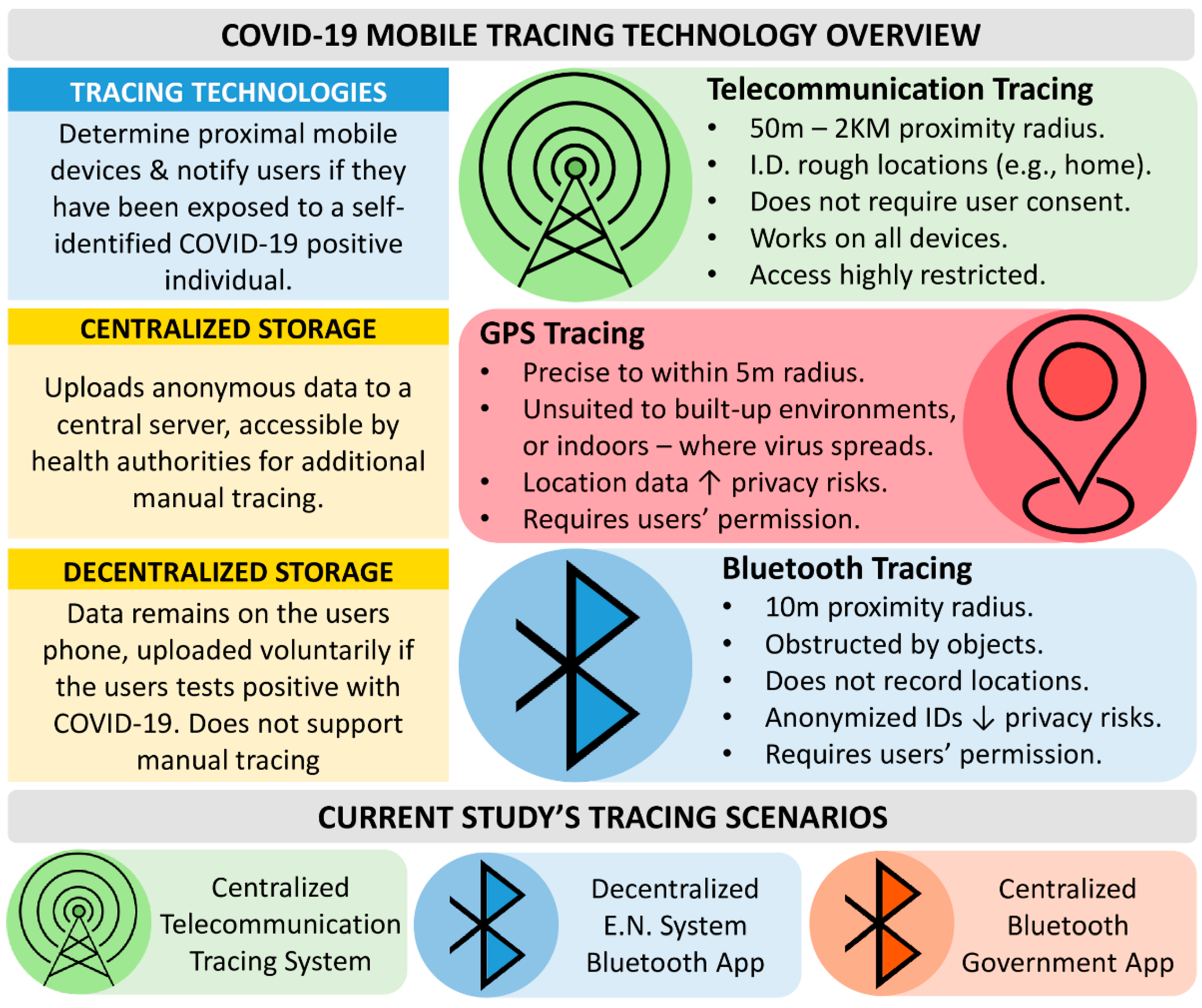
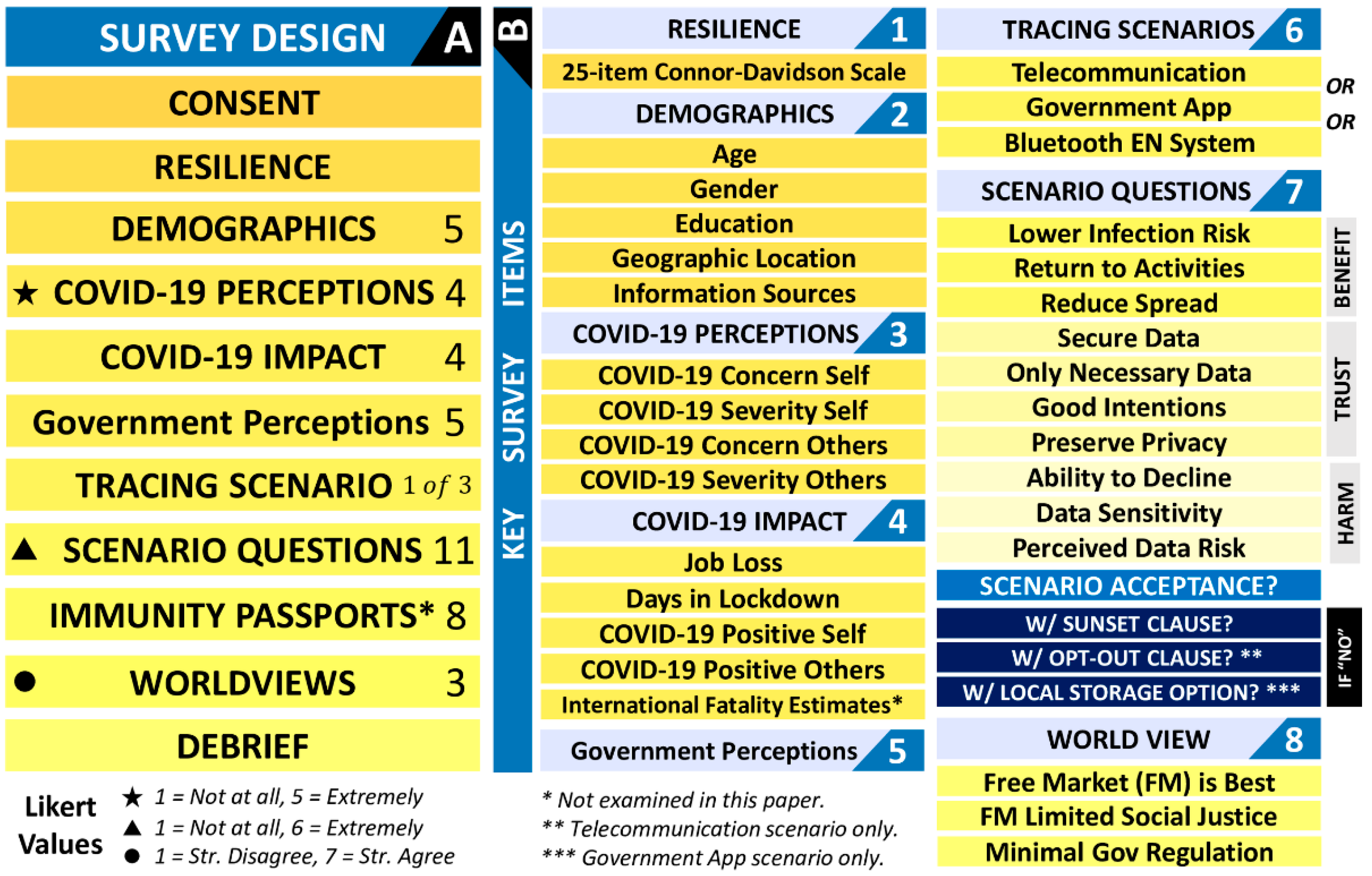
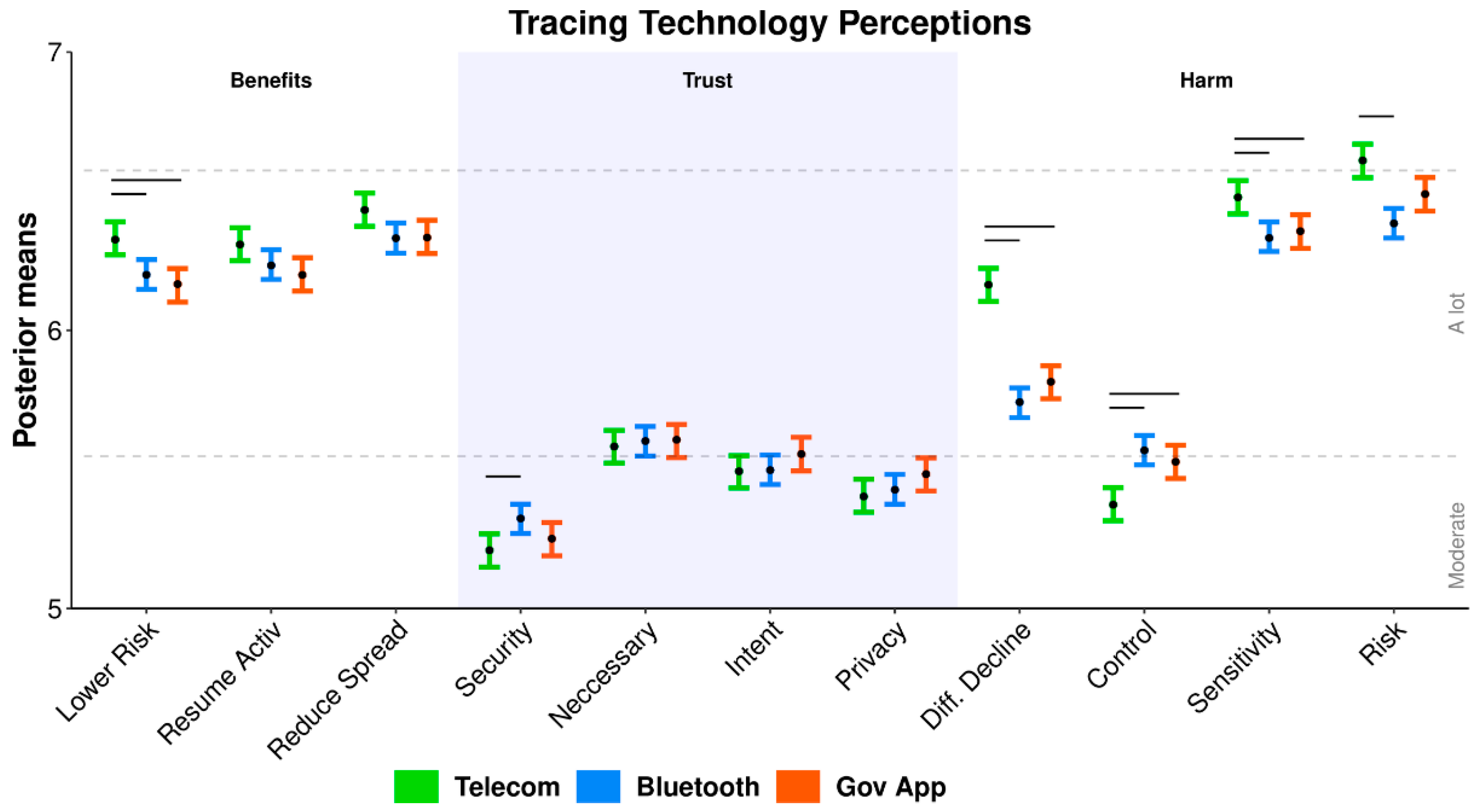
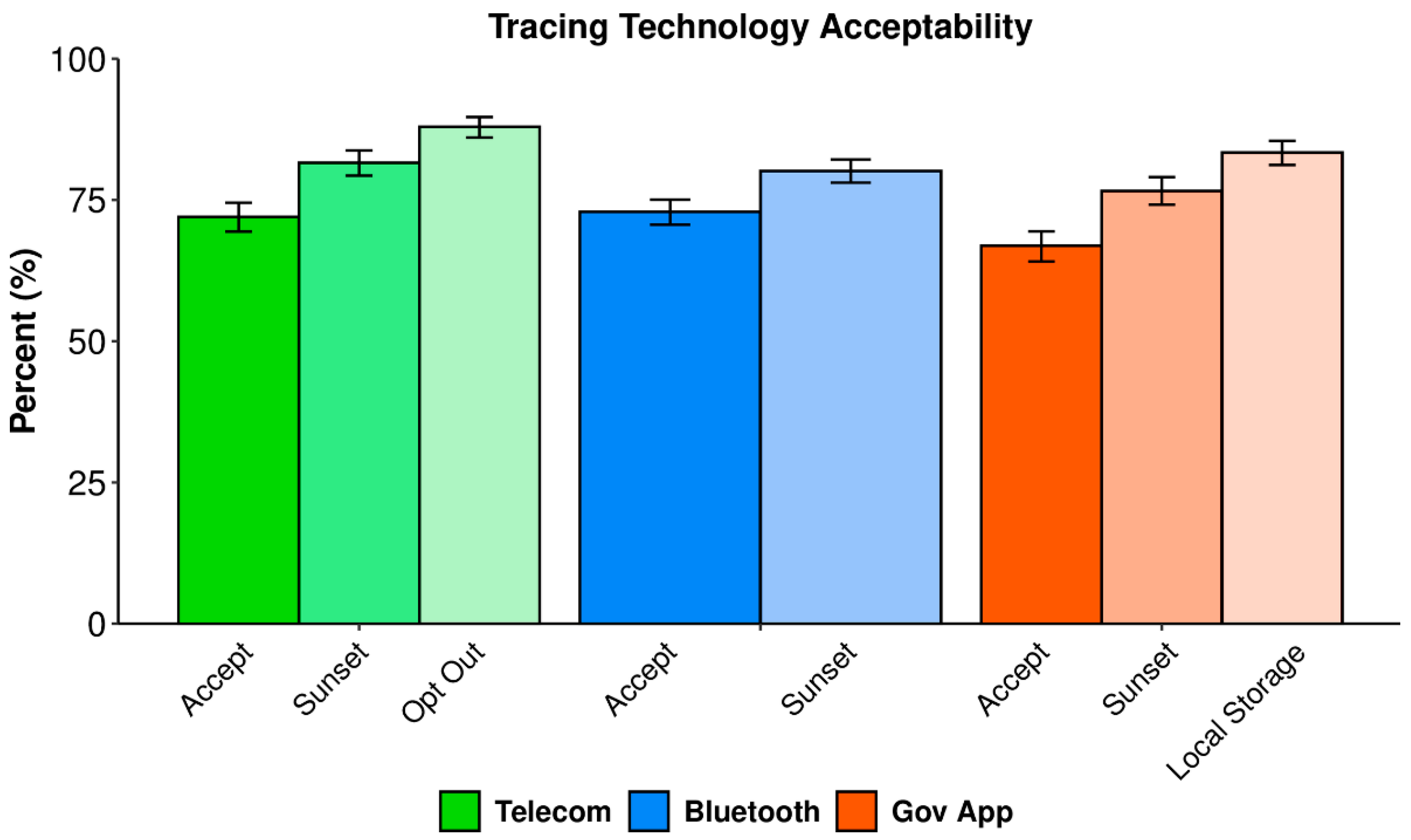
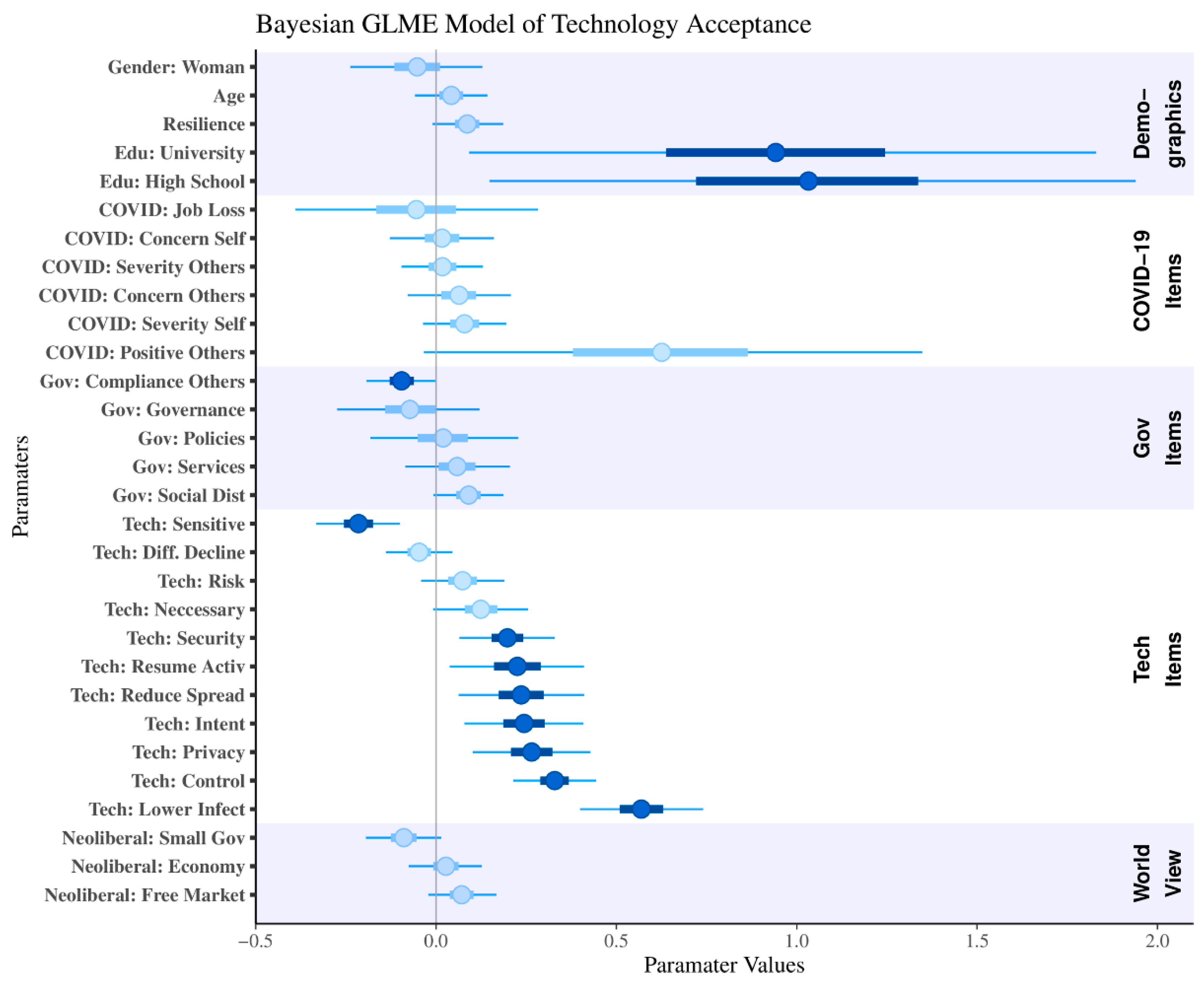
| Sample 1 | Sample 2 | Sample 3 | Sample 4 | ||
|---|---|---|---|---|---|
| Sample | Initial N | 1500 | 1500 | 1500 | 1500 |
| Final N | 971 | 1018 | 939 | 897 | |
| Mean Age | Years (SD) | 41 (12) | 40 (12) | 41 (12) | 41 (12) |
| Gender (%) | Male | 50 | 50 | 50 | 50 |
| Female | 50 | 50 | 50 | 50 | |
| Other Unspecified | 0 0 | 0.2 0 | 0.13 0.07 | 0.07 | |
| Education (%) | Pre High School | 1 | 1 | 1 | 1 |
| High School Grad University Grad | 12 86 | 14 85 | 14 85 | 16 | |
| Info Source (%) | News Online/Print | 59 | 63 | 63 | 64 |
| Television | 26 | 23 | 22 | 19 | |
| Social Media | 12 | 11 | 13 | 16 | |
| Friends and Family | 2 | 2 | 1 | 1 |
| Item Block | Question | Label |
|---|---|---|
| Perception 1 | How severe do you think novel coronavirus (COVID-19) will be for the general population? | Severity others |
| Perception 2 | How harmful would it be for your health if you were to become infected COVID-19? | Severity self |
| Perception 3 | How concerned are you that you might become infected with COVID-19? | Concern self |
| Perception 4 | How concerned are you that somebody you know might become infected with COVID-19? | Concern others |
| Impact 1 | Have you ever tested positive to COVID-19? | Positive self |
| Impact 2 | Has somebody you know ever tested positive to COVID-19? | Positive others |
| Impact 3 | How many days, if any, have you been in quarantine or self-isolation? | Lockdown days |
| Impact 4 | Have you temporarily or permanently lost your job as a consequence of the COVID-19 pandemic? | Job loss |
| Gov 1 | What percentage of the population do you think is complying with government policies regarding social distancing? | Social dist. |
| Gov 2 | What percentage of the population do you think is complying with government policies regarding COVD-19? | Compliance |
| Gov 3 | How satisfied are you with the current Government’s governance? | Governance |
| Gov 4 | How satisfied are you with the current Government policies? | Policies |
| Gov 5 | How satisfied are you with the current Government’s public services? | Services |
| Benefit 1 | How confident are you that the described scenario would reduce your likelihood of contracting COVID-19? | Lower infection |
| Benefit 2 | How confident are you that the described scenario would help you resume your normal activities more rapidly? | Resume activities |
| Benefit 3 | How confident are you that the described scenario would reduce the spread of COVID-19? | Reduce spread |
| Trust 1 | How secure are the data that would be collected? | Data security |
| Trust 2 | To what extent is the Government (Apple/Google) only collecting the data necessary to achieve the purposes of the policy? | Data necessary |
| Trust 3 | How much do you trust the Government (Apple/Google) to use the tracking data only to deal with the COVID-19 pandemic? | Trust intentions |
| Trust 4 | How much do you trust the Government (Apple/Google) to be able to ensure the privacy of each individual? | Trust privacy |
| Harm 1 | How difficult is it for people to decline participation? | Difficulty decline |
| Harm 2 | To what extent do people have ongoing control of their data? | Ongoing control |
| Harm 3 | How sensitive are the data being collected? | Data sensitivity |
| Harm 4 | How serious is the risk of harm from the proposed scenario? | Risk |
| Worldview 1 | Economic systems based on free markets unrestrained by government interference automatically work best to meet human needs. | Economy |
| Worldview 2 | The free market system may be efficient for resource allocation, but it is limited in its capacity to promote social justice. | Free market (R) |
| Worldview 3 | The government should interfere with the lives of citizens as little as possible. | Small gov |
| Sample 1 | Sample 2 | Sample 3 | Sample 4 | |
|---|---|---|---|---|
| Mean Days in Lockdown (SD) | 0.62 (3) | 0.62 (3) | 0.77 (3) | 0.78 (3) |
| Job Loss (%) | 7 | 9 | 8 | 8 |
| Tested Positive Self (%) | 0.53 | 0.73 | 0.8 | 0.33 |
| Tested Positive Others (%) | 3 | 2 | 3 | 3 |
| Mean Resilience (SD) | 64 (15) | 64 (15) | 65 (15) | 65 (15) |
Publisher’s Note: MDPI stays neutral with regard to jurisdictional claims in published maps and institutional affiliations. |
© 2022 by the authors. Licensee MDPI, Basel, Switzerland. This article is an open access article distributed under the terms and conditions of the Creative Commons Attribution (CC BY) license (https://creativecommons.org/licenses/by/4.0/).
Share and Cite
Garrett, P.M.; Wang, Y.-W.; White, J.P.; Kashima, Y.; Dennis, S.; Yang, C.-T. High Acceptance of COVID-19 Tracing Technologies in Taiwan: A Nationally Representative Survey Analysis. Int. J. Environ. Res. Public Health 2022, 19, 3323. https://doi.org/10.3390/ijerph19063323
Garrett PM, Wang Y-W, White JP, Kashima Y, Dennis S, Yang C-T. High Acceptance of COVID-19 Tracing Technologies in Taiwan: A Nationally Representative Survey Analysis. International Journal of Environmental Research and Public Health. 2022; 19(6):3323. https://doi.org/10.3390/ijerph19063323
Chicago/Turabian StyleGarrett, Paul M., Yu-Wen Wang, Joshua P. White, Yoshihsa Kashima, Simon Dennis, and Cheng-Ta Yang. 2022. "High Acceptance of COVID-19 Tracing Technologies in Taiwan: A Nationally Representative Survey Analysis" International Journal of Environmental Research and Public Health 19, no. 6: 3323. https://doi.org/10.3390/ijerph19063323
APA StyleGarrett, P. M., Wang, Y.-W., White, J. P., Kashima, Y., Dennis, S., & Yang, C.-T. (2022). High Acceptance of COVID-19 Tracing Technologies in Taiwan: A Nationally Representative Survey Analysis. International Journal of Environmental Research and Public Health, 19(6), 3323. https://doi.org/10.3390/ijerph19063323








